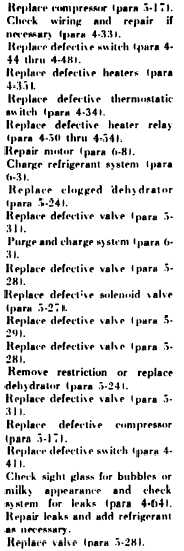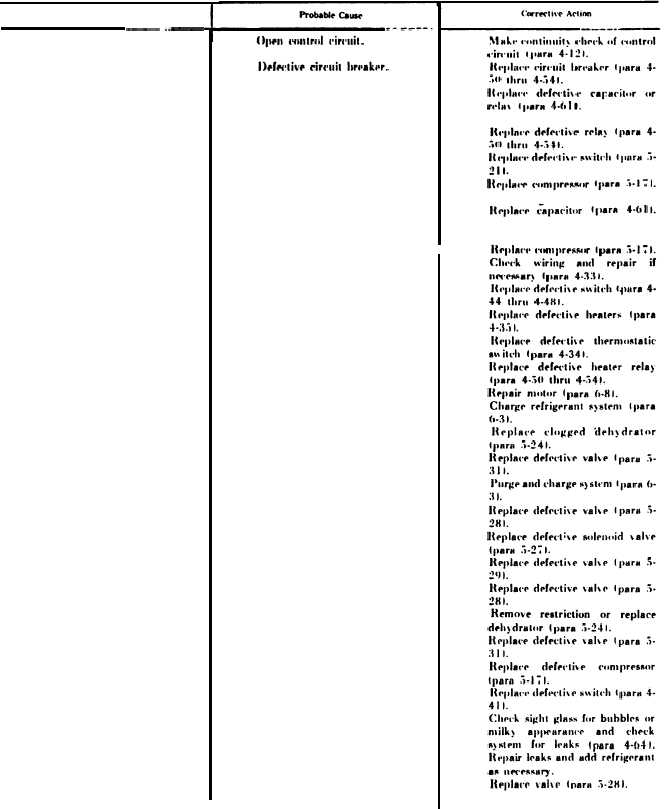|
| |
para 4-64
para 5-28
para 4-41
para 5-17
para 5-31
para 5-24
para 5-28
para 5-29
para 5-27
para 5-28
para 6-3
para 5-31
para 5-24
Para 6-3
para 6-8
para 4-50
para 4-54
para 4-34
para 4-35
para 4-44
para 4-48
para 4-33
para 5-17
para 4-61
para 5-17
para 5-21
para 4-51
para 4-54
para 4-61
para 4-51
para 4-12
5-5. Troubleshooting Chart
by a list of probable causes of the trouble. The
Troubleshooting procedures for direct and general
corrective action recommended is described op-
support maintenance are listed in table 5-1. Each
posite the probable cause.
trouble symptom or malfunction stated is followed
Malfunction
— -—
1. pressor will not start,
2.
3.
Compressor starts but goes out on
overload.
Little or no heating capacity.
4. Insufficient cooling.
5. Low suction pressure.
6. Low discharge.
7. Low suction
and discharge
pressure.
a.
b.
C.
d.
e.
f.
a.
b.
a.
b.
c.
d.
e.
f.
a.
b.
c.
d.
e.
f.
g.
a.
b.
c.
a.
b.
a.
b.
Defective starting relay or
capacitor (single phase com-
pressor).
Defective phase sequence relay
(three phase compressor).
Defective high or low pressure
cutout switch.
Defective compresser motor or
thermal protector.
Defective
compressor
run
capacitor (single phase com -
pressor).
Defective comprerssor.
Loose electrical connections or
faulty wiring.
Defective temperature selector
switch or mode selector switch.
Defective heaters.
Defective heater high tem-
perature cut out switch.
Defective heater relay.
Defective evaporator fan motor.
Low refrigerant charge.
Dehydrator clogged.
Pressure
regulator
valve
defective.
Air in refrigerant system,
Thermal
expansion
valve
defective.
Defective solenoid valve.
Defective quench thermal ex-
pansion valve.
Defective thermal expansion
valve.
Dehydrator clogged or defective.
Pressure
regulating
valve
defective.
Compressor not pumping due to
defective compressor.
Defective high-low condenser fan
thermostatic switch.
Lack of refrigerant.
Defective thermal expansion
valve.
a .
b.
c .
d.
e.
f.
a.
b.
a.
b.
c .
d.
e.
f.
a.
b.
c.
d.
e.
f .
g.
a.
b.
c.
a.
b.
il.
b.
5-3
|




